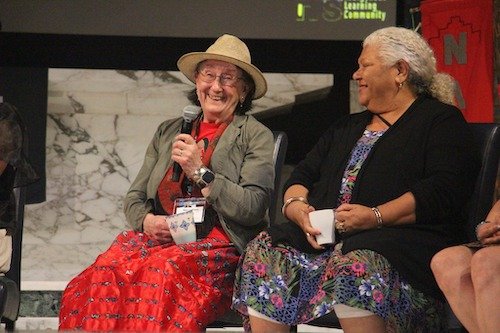Members of NAIITS: An Indigenous Learning Community lifted up “The Voices of the Matriarchs and Women in Community” from June 5-7, 2025, at the 22nd NAIITS symposium at Tyndale University and Seminary in Toronto.
“This evening is a special evening,” NAIITS Director Shari Russell said as the symposium began.
“It is focusing on our women — on those who have been influencers in our community, those who have influenced us and impacted us.”
Every summer, the NAIITS symposium gathers academics, pastors and practitioners around a single topic, editing the papers and presentations they give over three days into a volume of “The Journal of NAIITS: An Indigenous Learning Community” that is released the following year.
The idea for a symposium focused on the insight of Indigenous women came nearly a year and a half before as the Canadian Learning Community for Decolonization and Innovation in Theological Education (CLC) led members of the NAIITS community through an Indigenous Appreciative Inquiry process to discuss what the Learning Community looks like at its best and dream about what that could look like in the future.
One of the values that quickly emerged is the way the NAIITS community has affirmed women’s leadership from its beginning, Shari said.
She added, “When we began dreaming and looking at these values of who we are as a NAIITS community and how we live that out in community, there was an obvious connection to symposium. So many of us know NAIITS because of the symposium … and the papers and presentations that are given throughout every symposium were faithfully gathered together, edited and curated by Wendy Peterson.”
“She is the matriarch, I would say, of the NAIITS journal.”
Wendy, a member of the founding board of NAIITS, walked on in 2018, not long after receiving her PhD. The symposium began with several members of the NAIITS community sharing reflections on her legacy and reading highlights of her dissertation, “A Gifting of Sweetgrass: The Reclamation of Culture Movement and NAIITS: An Indigenous Learning Community.”
Other presentations included "Intergenerational Resilience: Honouring the Matriarchal Legacy of Guunggandji Language, Songlines and Dance” by Nathan Schrieber and his family; "Voices of Resilience and Leadership: Women’s Roles in Community, Tradition and Transformation in Mindanao" by leaders of iEmergence Philippines; a panel of reflections from a number of aunties in the NAIITS community; "Redefining the Angry Māori Woman: How Six Māori Women (wãhine) Navigate Gendered and Racial Prejudice to Achieve Spiritual and Mental Wellness" by Irene Farnham; "The Women's Lodge and Theological Education" by Shari Russell and Anna Robbins; “Geneaology of Native Feminist Thought" by Andrea Smith; and "Matriarchal Hlampko ('Strength') in the Wilderness: The Story of Hagar Re-envisioned on the Trail of Tears” by Amy Allan.
The symposium also created space for music, for families, for those who needed spiritual and emotional support as presentations dealt with difficult topics, for the voices of missing and murdered Indigenous women that were missing from symposium — and even for a joyful round dance that wound around NAIITS’s tipi, considered to be the women’s lodge, in the courtyard on Tyndale’s campus.
In addition, the Learning Community celebrated the graduation of six co-learners at convocation:
- Mackenzie Griffin graduated with a Master of Theological Studies degree.
- Jennifer Mason graduated with a Master of Arts in Intercultural Studies degree.
- Marlene Wolters graduated with a Master of Theological Studies degree.
- Mike Hogeterp graduated with a Doctor of Philosophy degree.
- Andy Mitchell graduated with a Doctor of Philosophy degree.
- Shari Russell graduated with a Doctor of Philosophy degree.
Marlene, who spoke on behalf of NAIITS’s graduate students, shared how transformational her journey with the Learning Community has been.
“We are leaving this program, not as experts, but as stewards of what we've learned — stewards who are called to carry this learning into classrooms, circles, congregations, policy, tables and community,” she said. “The call now is not only to remember what we've studied, but to embody it.”
To view more photos from the NAIITS symposium, visit the NAIITS: An Indigenous Learning Community Facebook page.
